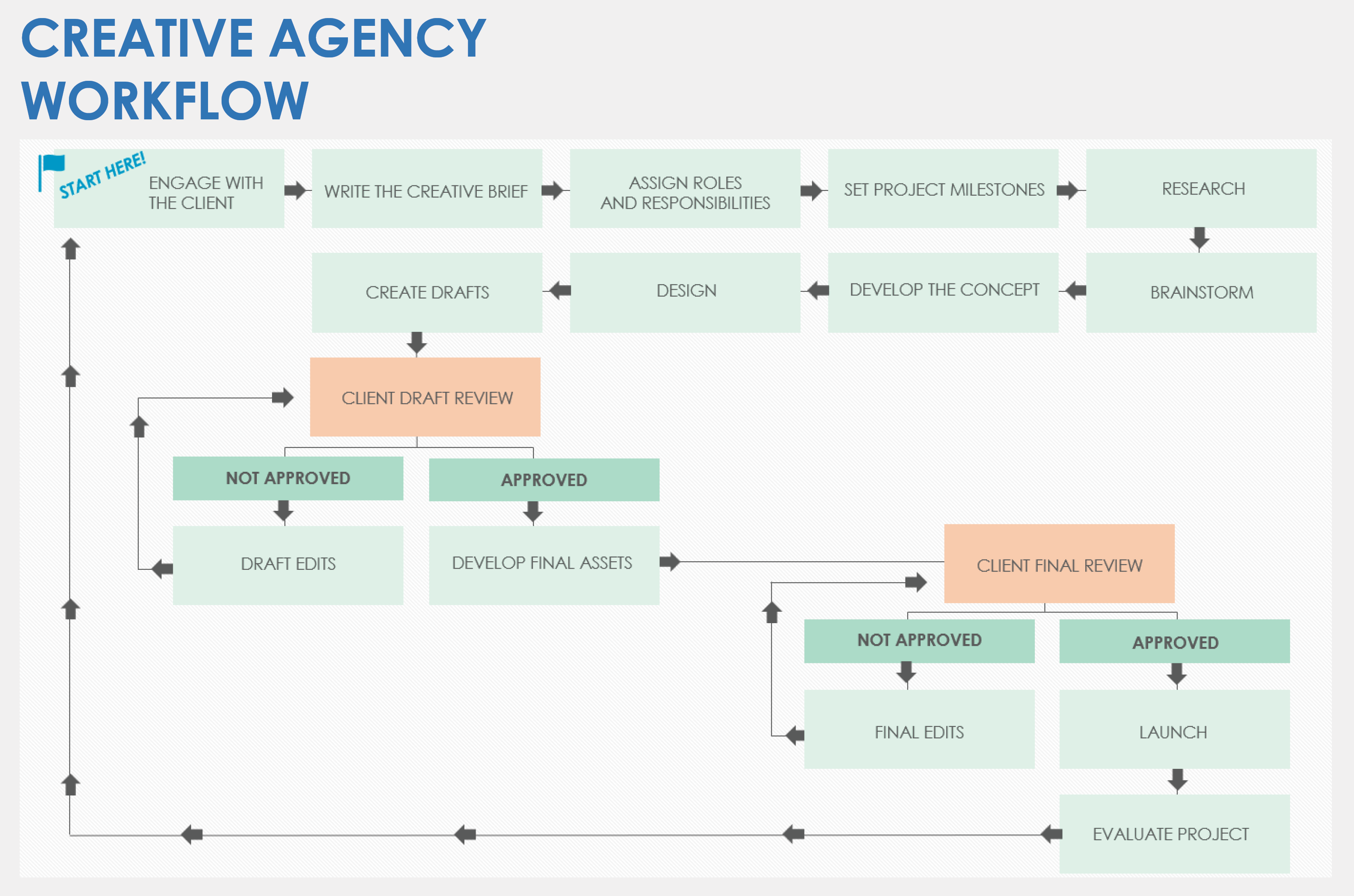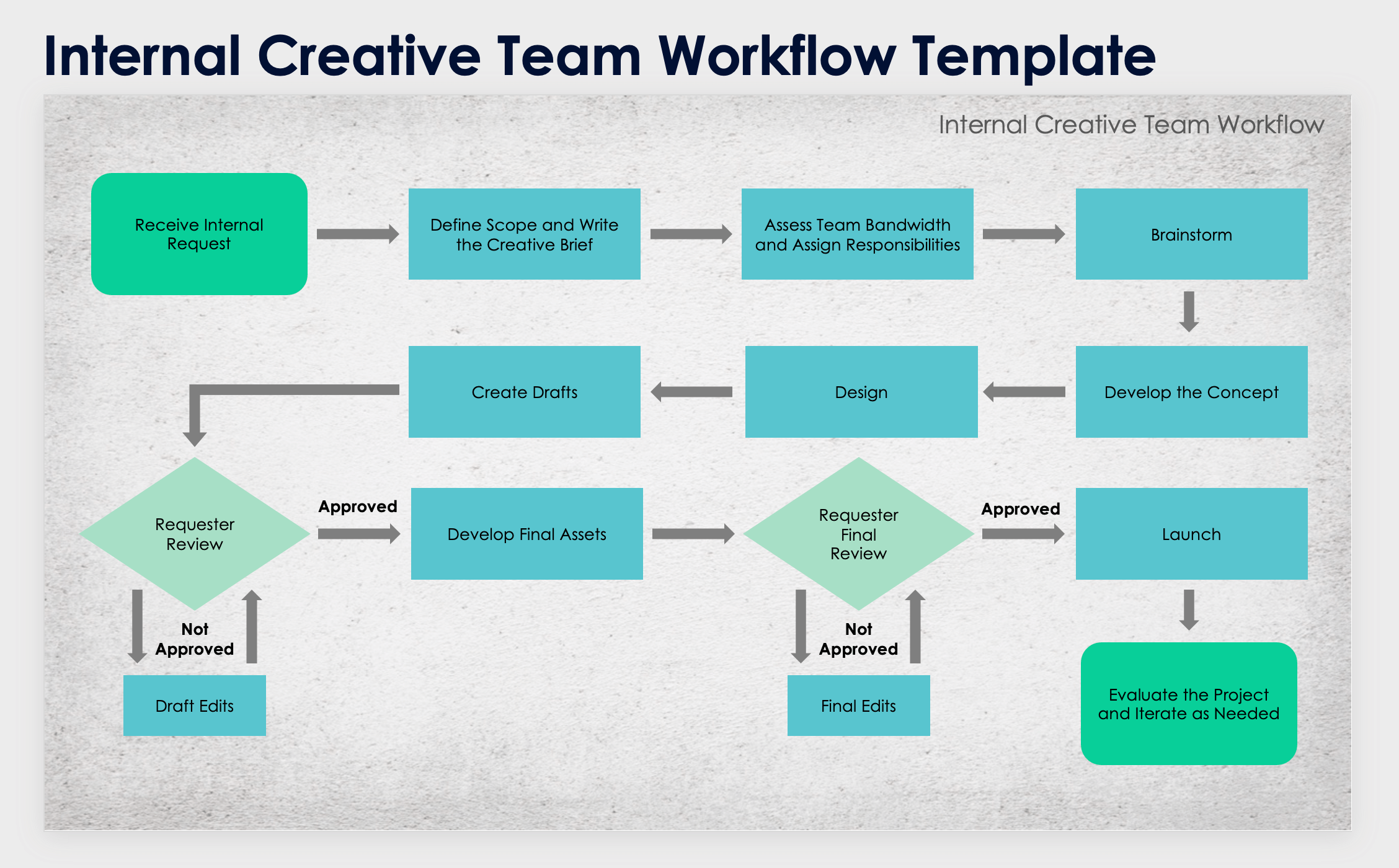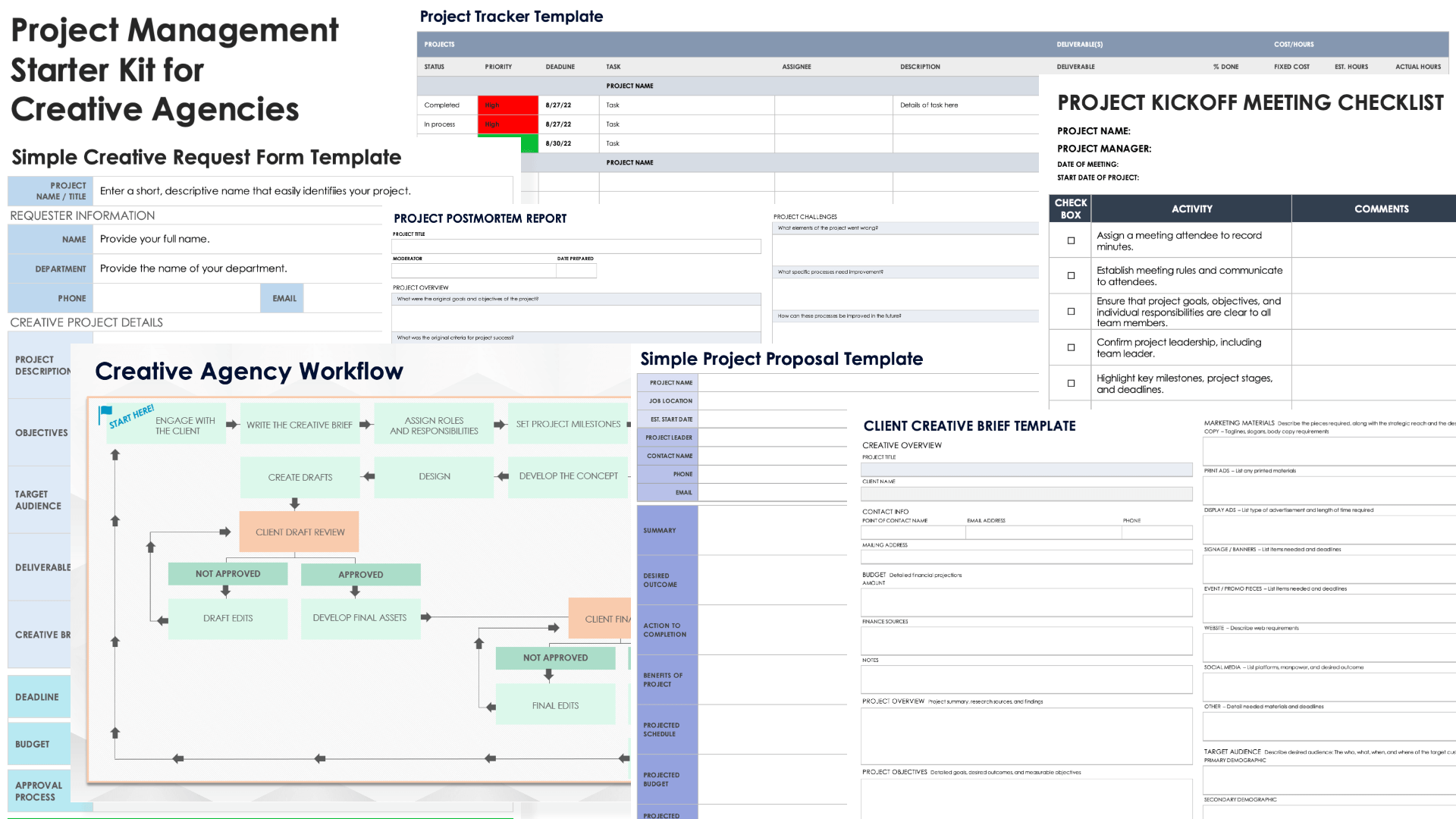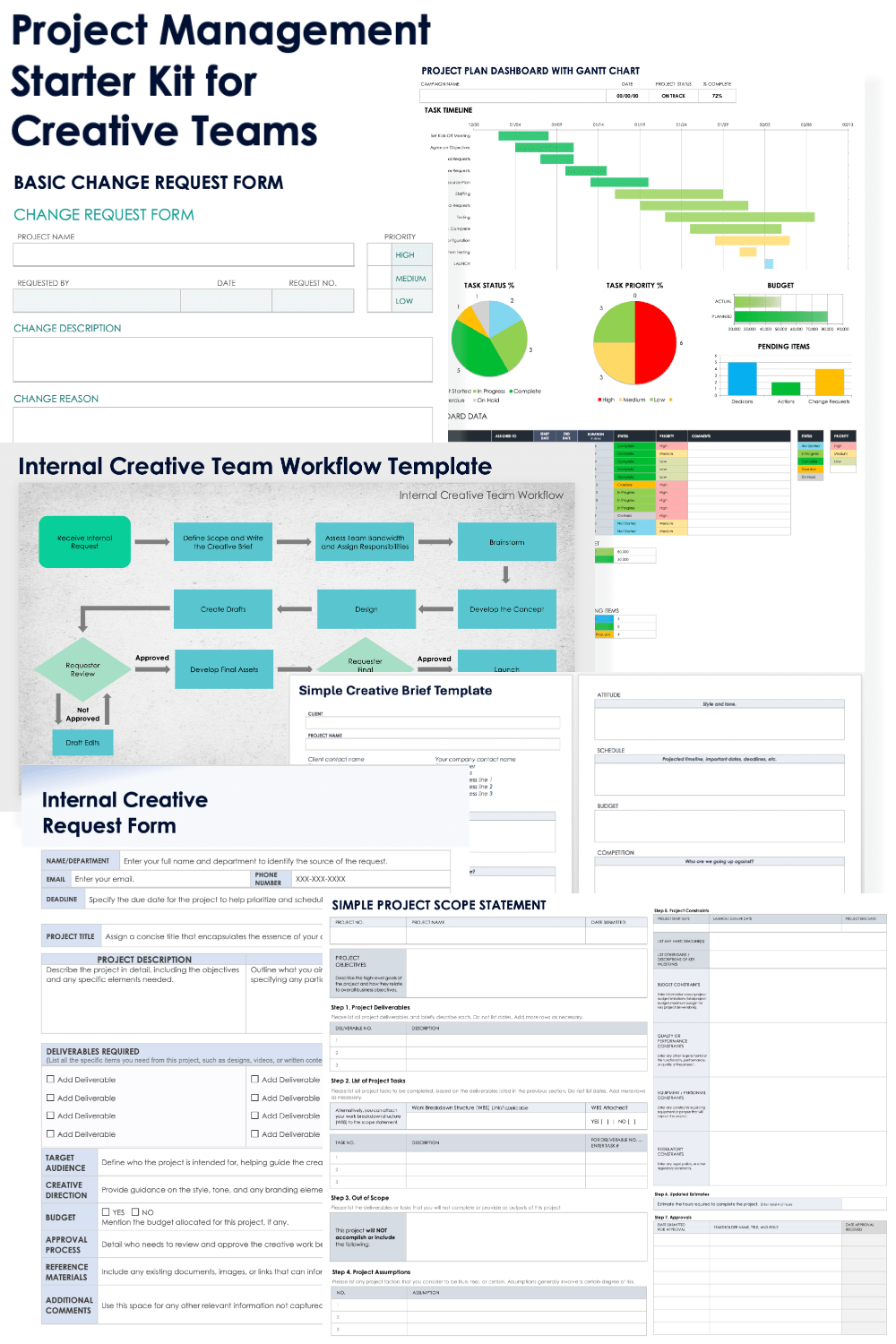What Is Creative Project Management?
Creative project management (CPM) is the process of guiding a team's effort to complete a project while fostering an environment that encourages creative ideas to flourish. This process involves balancing structured planning with the flexibility needed to embrace creative development.
The Difference Between Creative Project Management and General Project Management
Creative project management focuses on leading teams in environments such as marketing or advertising, where nurturing creativity is crucial. Traditional project management typically involves a more structured process used in fields such as construction or software development.
While these two styles have a different approach, they share the same core lifecycle and can be integrated to enhance business success and project outcomes.
Traditional project management follows a clear roadmap from beginning to end, wherein a project manager identifies roles, tasks, tools, and resources. Over the years, PMs have established and created this formal end-to-end process. Creative projects, however, don’t produce bridges or buildings. Advertising agencies, creative studios, and marketing departments are filled with idea people. Because creative projects aren’t measured by technical specifications, project managers from other industries often struggle with creative projects.
Jillian Knoepfel, Content Operations Manager at Smartsheet, explains the difference from the project manager perspective: “A creative project manager should carry out the same foundational duties that are expected from a general project manager. They should ensure that the project is on track and on budget; they should be certain that stakeholders and teams have the right information at the right time. With a holistic view of all the project components, they should be making sure that all the moving parts and people involved are connecting at the right touchpoints and advancing toward the same goal. In addition, the creative project manager should take the general project management role one step further by leveraging their knowledge of creative processes and their empathy for creative teams to deliver a project successfully.”
Like traditional projects, creative projects are time bound — they have start and end dates. So, in addition to meeting time constraints, PMs also have to manage costs and work within those boundaries. Moreover, creative project managers have to face a further challenge because creative projects are often interrelated, with tasks and activities that depend on one another.
Here are the major characteristics of creative projects:
- Creative Work Is Subjective: Creative work is hard to quantify. There are few metrics or key performance indicators (KPIs) for a good design. While nothing supersedes high-quality work, “quality” is hard to define. Establish criteria with objective language, but leave room for the creative process to evolve during a project.
- Creative Projects Are Unique: They may be similar to other projects, but they are never identical. One advertising campaign can build on elements of another, but each project is unique and you must approach each accordingly.
- Creative Projects Require Special Communication Skills: You have to translate what your clients need into specific tasks that the team can accomplish. When you manage a project, you need shared vocabulary, so you can explain what works and what doesn’t.
- A Creative Project’s Objectives Are Often Undefined: The objectives of your project are driven by the goals of the project. They need to be specific and measurable. One way to arrive at these objectives is to follow the SMART process: specific, measurable, achievable or attainable, realistic, and time bound. Learn more about writing SMART objectives and use this SMART goals template to help you.
- Creative Projects Rely on Collaboration: Unlike technical projects, which typically follow a straightforward process, creative projects are highly collaborative, unleashing creativity. In successful projects, everyone works together because collaboration is baked into every facet of the team. Involve team members when setting targets and evaluating and assigning roles. Nurture the less engaged and introverted members of the team. Encourage senior members of your team to mentor the less experienced staff. From the kickoff meeting (when you align your departments with the project goals) to the final presentation, you can monitor collaboration with regular team meetings and smaller group check-ins.
- Creative Projects Change Frequently: Clients may change their minds about what they want. Team members may have a better idea about the direction of a project. The vision of your stakeholders might not line up with your team’s creativity. While change is inevitable in any project, strong client onboarding can help you avoid surprises later. At the same time, leave enough wiggle room for creative flexibility within the project. Don’t commit to so many specifics that your team won’t be able to put its best work forward.
“If it’s true that project management is like herding cats, creative project management is like herding toddlers that are determined to draw on your walls in crayon,” says Nuala Turner, editor at The Digital Project Manager. “You still need to get everyone working to achieve the project goal on time, but you also need to leave space for creativity, which isn’t always a predictable or linear process.”
Check out this creative operations management guide for additional information on how to streamline your internal creative operations and reap the benefits of creative operations management.
Creative Project Management Process
Creative project management adapts the traditional project management cycle to meet the unique demands of creative projects. While it follows the familiar steps of initiation, planning, execution, monitoring, and closure, creative project management incorporates specific nuances at each stage.
These adjustments ensure that the creative process remains flexible and open to innovation, while still providing the structure needed to meet project goals and deadlines effectively.
Oscar Ramirez, Design Director at Smartsheet, explains where the differences in the project management cycle are most notable: “The foundational stages of project management, including scoping, conceptualization, and development, remain consistent. However, the process of gathering requirements differs significantly, especially for external agencies. These agencies must conduct more extensive requirement gathering to address all the technical aspects they neither control nor manage directly. This process requires engaging with a variety of stakeholders and adjusting the scope and details of deliveries based on client payments. Because of the number of deliveries, the types of files you deliver, and the level of detail required in each phase, the delivery stage in a CPM cycle is also different than that in a traditional PM cycle. In fact, you must manage all stages quite carefully in order to meet these expanded requirements.”
“For creative projects, the initiation and planning phases often take up a significant amount of time, leaving little room for execution. It's common for planning to consume 80 percent of the timeline, which can cramp the execution phase. As a project manager, you need to ensure that you’re allocating enough time for actual project execution,” explains Cinthya Ramírez, Creative Project Manager at Smartsheet. "Creative project management must be flexible because creative work, such as designing a video or a webpage, isn't just about following a strict process. It involves generating ideas and revisions based on feedback, which can sometimes significantly alter the project timeline."
Creative Project Management for Creative Teams
Project managers guide the work, but the team makes projects come to life. Therefore, your success depends on fostering an environment that nurtures creatives and encourages collaboration. Your company’s culture is critical to setting a tone of transparency and sharing.
The secret ingredients are your vision and philosophy for bringing people together and giving everyone a voice.
This approach plays out in how you establish your creative workflow. You’ll need to clarify roles and responsibilities to avoid duplication or conflict, while also encouraging collaboration. As you map out the workflow to support a project’s scope, make room for both creativity and efficiency. And consider software tools that work best for your team’s structure and style. Learn more about creating and implementing a creative workflow for your organization below.
When comparing a creative agency with an internal creative team, there are many qualities that overlap, but also multiple differences that impact the way in which creative projects are managed. The following table highlights some of the key differences between the two, as identified by Knoepfel:
Characteristic | Internal Creative Team | Creative Agency |
|---|---|---|
| Focus and expertise | An internal team typically has a deeper understanding of the company's brand, culture, and long-term business goals. It can develop customized content more quickly, i.e., content that aligns closely with the company’s strategic objectives. | An agency often brings a broader range of experiences and industry best practices due to working with a diverse set of clients. It can provide fresh perspectives and ideas that an internal team might overlook. |
| Scalability and flexibility | An internal team may have limitations in scaling up quickly due to hiring constraints and budget limitations. However, it offers more stability and continuous availability. | An agency may take more time to get up and running on projects due to onboarding. However, once fully briefed, it can scale resources up or down depending on the project needs, providing greater flexibility for short-term and large-scale projects. |
| Creativity and innovation | While highly knowledgeable about the brand, an internal team might become entrenched in company norms and less likely to challenge the status quo, potentially limiting creativity. | An agency often brings a fresh, outsider perspective that can spur innovation and creative solutions. Its exposure to different industries and trends can lead to more diverse and cutting-edge ideas. |
| Turnaround time and efficiency | An internal team’s familiarity with internal processes and direct access to other departments can lead to faster decision-making and execution for certain projects. However, it may also get bogged down by internal bureaucracy. | While, initially, an agency might need more time to understand the brand and its needs, it often has well-honed processes for delivering high-quality work efficiently. However, the need for coordination and communication with the client can sometimes slow things down. |
| Cost structure and benefits | An internal team usually consists of salaried employees, leading to predictable and often lower long-term costs. However, its initial setup and ongoing overhead (salaries, benefits, training) can be significant. | An agency tends to work on a project or retainer basis, which can be expensive but offers flexibility. Costs are more variable and can be high for specific campaigns, but there is no ongoing overhead when an agency is not in use. |
Creative Project Management for Creative Agencies
Successful creative agencies have built reliable processes, so they avoid starting from scratch with every project. But an agency’s process varies with client requirements. The most successful agencies are fanatical about their process because they’ve learned what works.
Make sure that your process reflects your core communication and collaboration values and that it includes the following:
- A meeting and feedback schedule that involves clients at every stage
- Regular status updates to both internal and external stakeholders
- A main point of contact between the client (external) and your team (internal)
- An agency project manager who contributes at each step of the process
- Research for your project that mines qualitative data from your agency’s database and analyzes data from other sources
“Projects at creative agencies often have less flexible deadlines, tighter budgets, and fewer resources at their disposal than projects undertaken by internal creative teams,” explains Turner. “There’s less time and freedom to come up with creative concepts, and you’re often beholden to client demands, which typically aren’t all that creative. This means that project managers have to keep a tighter leash on their team when it comes to concepting and ideation and have to keep a closer eye on the timeline.”
“Project management in creative agencies tends to be more dynamic and deadline-driven due to diverse clients, while internal creative teams often have the advantage of intimate brand familiarity,” says Gianluca Ferruggia, General Manager at DesignRush. “This deep understanding can allow for greater flexibility and experimentation.”
Creative Project Management Best Practices
Unlike conventional project management best practices, creative PM best practices require consideration of the following factors: Creative work is subjective; creative projects are unique; creative projects require special communication skills; a creative project’s objectives are often undefined; creative projects rely on collaboration; and creative projects change frequently.
Turner’s best practices suggestions focus on three areas:
- Resource Allocation: “You need to pay attention to creative skills when allocating resources. Just because your designer can do UX work, that doesn’t automatically mean they can also craft a print ad. Make sure to assign work according to the team member’s creative expertise. This will help you keep to your timeline and ensure the team stays engaged in its work.”
- Time Estimates: “Pad your time estimates, especially for the concept and ideation stages. It can take time for creative inspiration to strike. Give your team a bit of extra time to come up with something great, but know when to cut it off and focus on the essentials. This way, you’ll strike a balance between staying on track with your timeline and coming up with a creative idea that will wow stakeholders.”
- Feedback: “Be mindful when giving feedback on creative work. Creative team members often feel emotionally attached to their work, so make sure you are constructive and encouraging with feedback. If you aren’t, team members might feel less safe sharing off-the-wall ideas, and you don’t want to stifle creativity.”
“A CPM shares many of the same best practices as a general PM. However, the following two abilities in particular set a successful CPM apart: being able to continuously develop skills to best support a creative team; and being able to give the team the tools to manage the underlying processes of a project and deliver it successfully,” says Knoepfel. “By leveraging a project management or work collaboration system that seamlessly connects to resource management and digital asset management tools, a CPM is better positioned to establish and automate consistent workflows, manage timelines and creative reviews, store and distribute creative digital assets, and remove roadblocks, so the creative team can focus and innovate.”
“In my experience, successful creative project management practices include communicating clearly , providing adequate scaffolding, understanding team dynamics, and maintaining a balance between delivering the client's vision and preserving creative integrity,” says Ferruggia. “One key consideration when managing creative projects is accounting for iterations and creative blocks. Scheduling buffer time and fostering an open, feedback-driven environment are essential to nurturing the creativity of the team.”
Cinthya Ramirez highlights the importance of setting clear expectations early. “In creative projects, it's crucial to set the right expectations about timing and process from the outset. To do this, you must be up front about the rounds of feedback and revisions, which helps manage stakeholder expectations and prevents last-minute rushes that can compromise the quality of creative output." She adds that “creative projects require ongoing communication and checks with stakeholders in order to monitor progress and make necessary adjustments. Effective project management integrates these checks into the workflow to ensure that everyone is aligned and the project stays on track."
Communication is vital, not only with stakeholders but also within creative teams. Sharing information is paramount to a project’s success. “Creativity Management from the Ad Agency Perspective,” a study from the Lulea University of Technology, concluded that the right communication process boosts creativity. As the authors explain, “It is important to keep an open flow of communication and stress the significance of internal communication between all levels. An open flow of communication smooths the sequence of work and sustains a high level of creativity in the workplace. Our findings motivate us to believe that communication is the utmost underlying cause for encouraging creativity in the workplace.”
Creative Project Management Examples
Creative project management prioritizes flexibility and creativity. Due to the unique demands of creative projects, which require specialized approaches and adaptability, a PM must employ project management strategies that are tailored distinctively to these demands.
“Creative projects involve more collaboration than non-creative projects. Project managers can facilitate collaboration by holding weekly brainstorm meetings and building multiple rounds of feedback into the creative process. Also, as requirements for creative projects tend to be more ambiguous, project managers need to be more diligent about getting approvals and direction from clients or project sponsors and must clearly communicate that information to their team,” explains Turner. “Keeping a creative team motivated is more nuanced than doing such with a non-creative team. Inspiration can strike at any time, but so can creative blocks. Project managers can facilitate short daily team-building exercises or brain warm-ups like word association games to get the creative juices flowing.”
“At our agency, we approach CPM as a dynamic process, which means extensive collaboration and brainstorming sessions. At the same time, we allow more flexibility and iteration, which often involves a lot of adjustments during the development process,” explains Tom Molnar, Operations Manager at Fit Design. “Plus, the project manager is prepared for any unexpected changes and is open to trying new approaches on the go. This can make the timeline less predictable but ultimately leads to a more innovative final product.”
“Creative project management, unlike general project management, requires a strong understanding of the creative process and mutual respect for artistic freedom. I've found the need to drive creativity without hampering it is a distinctive trait of creative project management,” emphasizes Ferruggia. “A typical example of creative project management could be managing a website design project. While the goals and deadlines may be similar to any other project, the variables like design variations, creative freedom, and iterations are unique, adding a different layer of complexity.”
Oscar Ramírez highlights differences between agencies and internal teams when it comes to project delivery and evaluation. "When managing internal creative teams, controlling processes is easier. You can iterate deliverables more frequently and quickly relaunch if something goes wrong — that often means fixing issues within minutes. In contrast, at an agency, where you lack control over internal mechanisms such as website management or direct access to technical support, you might have to wait for the next website update cycle to make changes.
“At an agency, you need to use metrics and KPIs to assess success and justify your changes, or you risk losing a contract,” he added. “The extent of measurements, the team's structure, and the KPIs you establish are crucial. Additionally, the documentation required to manage your processes becomes more detailed the less control you have over a project. In contrast, in-house teams often need less documentation because they have greater control over internal factors than agencies do.”
In real-life creative project management, flexibility is not just beneficial, it's essential. Cinthya Ramirez notes that creative work requires a management approach that accommodates unexpected changes without compromising the project timeline. She uses flexible scheduling rather than fixed deadlines in order to create broader time frames, so she can account for the variability in creative tasks.
"As a creative project manager, I've learned the importance of setting realistic expectations,” says Cinthya Ramirez. “For instance, while we might plan to complete the initial phase in a week and then proceed to stakeholder reviews, the reality is that the feedback could lead to significant changes. It’s crucial to understand that sometimes, regardless of our initial plans, we may need to extend timelines to accommodate these changes. This flexibility allows us to manage projects more effectively, ensuring that all parties understand the fluid nature of creative work and the potential need for adjustments."
Creative Project Management Workflows
To effectively meet client expectations, creative agencies and internal teams must establish robust, repeatable processes. Creative workflow management, essential to creative operations, involves four key phases: definition, creation, review, and launch.
This systematic process ensures that the development of creative assets meets quality, budget, and timeline expectations. Both external agencies and internal teams benefit from such structured workflows. Learn more about creative workflow management.
Creative Agency Workflow

Download the Creative Agency Workflow for PowerPoint
This creative agency production process workflow outlines the essential steps for managing creative projects within an agency, from initial client engagement to final project evaluation.
Internal Creative Team Workflow

Download the Internal Creative Team Workflow for PowerPoint
This creative process workflow outlines the essential steps for managing creative projects within internal creative teams, going from the internal work request to project evaluation and iteration.
Check out additional creative agency workflows to learn how these processes guide projects from inception to completion, managing the entire process for each type of deliverable.
Project Management Starter Kit for Creative Agencies

Download the Project Management Starter Kit for Creative Agencies
Get all the essentials for creative project management in creative agencies with this free, downloadable starter kit. It includes a set of templates designed to help you plan and organize your projects efficiently. You can download the entire kit or select individual templates to meet your specific needs.
Included in this kit, you’ll find the following templates:
- This project kickoff meeting checklist template in Microsoft Word format includes a simplified list of tasks to complete.
- This simple creative request form template in Excel , Microsoft Word , and Adobe PDF formats is extremely easy to use, with clear sections for all of the essential information to get started.
- This client creative brief template in Excel and Microsoft Word formats allows you to work with your client to identify the project’s goals and objectives, overall budget and timeline, and roles and responsibilities.
- This project tracker template in Excel format lets you add tasks, status, priority, deliverables, deadlines, cost, hours, and more for your whole project.
- This project postmortem report template in Excel , Microsoft Word , and formats is your go-to tool once the project is completed and it’s time to evaluate what worked, what didn’t, and what can be improved for the next project.
- This project proposal template in Excel and Adobe PDF formats breaks the proposal into clearly delineated sections, providing an organized layout that is easy to use and read.
- This creative agency workflow diagram template in PowerPoint format outlines the essential steps for managing creative projects within an agency, from initial client engagement to final project evaluation.
Project Management Starter Kit for Creative Teams

Download the Project Management Starter Kit for Creative Teams
Access all the essentials for creative project management of internal creative teams with this free, downloadable starter kit. Assembled below are a collection of templates to assist you in planning and organizing your projects efficiently. Download the entire kit or select the individual templates that meet your needs.
Included in this kit, you’ll find the following templates:
- This internal creative project request form in Microsoft Word and Adobe PDF formats includes sections for deadline and approval details, which makes it easier for internal teams to manage projects.
- This creative brief template in Microsoft Word format offers a basic outline to help you stay focused and plan efficiently.
- This basic change request form template in Microsoft Word and Adobe PDF formats helps you streamline your change request process.
- This project scope statement template in Microsoft Word , Excel , and Adobe PDF formats provides a simple layout for creating a scope statement.
- This project management dashboard template for Excel helps you stay on top of multiple aspects of a given project and view them in a single snapshot.
- This internal creative team workflow diagram template in PowerPoint format outlines the essential steps for managing creative projects within internal creative teams, going from the internal work request to project evaluation and iteration.
Crucial Project Management Software Features for Managing Creative Projects
Choosing the right project management software is vital to the success of creative projects, which thrive on a blend of flexibility, collaboration, and precise organization. From collaborative workspaces to access control and permissions, these features ensure that creative teams can focus on innovation while managing project details efficiently.
- Collaborative Workspaces: These environments facilitate real-time brainstorming, feedback, and idea sharing, which are central to creative processes.
- Visual Project Planning Tools: Gantt charts, Kanban boards, and other visual tools are vital to mapping project timelines and understanding workflow dependencies.
- Flexible Task Management: Drag-and-drop scheduling and adjustable timelines allow for the dynamic nature of creative work.
- File Sharing and Version Control: These features are essential for managing creative assets, thus ensuring that everyone is working with the most up-to-date files.
- Project Dashboards: Such tools provide at-a-glance insights into project health, timelines, and resource management — data that is central to quick decision-making.
- Integrated Communication Tools: Built-in tools for seamless communication enhance coordination and ensure that all stakeholders are aligned.
- Time Tracking: This feature helps you manage project budgets and understand how you and your team spend your time — data that is critical for efficiency.
- Automation: This tool automates repetitive tasks such as notifications, scheduling, and standard updates, enhancing project efficiency.
- Customizable Workflows: This feature supports the unique needs of your project by allowing your teams to tailor workflows to their specific creative processes.
- Resource Management: This software feature ensures that you allocate your resources properly without overstretching your capabilities, a tool that is crucial for project sustainability.
- Integrations: This feature allows you to seamlessly connect with other tools such as design software, enhancing your workflow continuity.
- Reporting and Analytics: This data provides insights into project progress and performance metrics, which are key to making decisions and adjustments.
- Access Control and Permissions: This security feature manages who can see and edit different project elements, making it an indispensable tool for maintaining project integrity.
Check out the top creative project management software features, according to industry experts.
Super-Charge Your Agency or Team’s Creative Capabilities with Creative Project Management Software from Smartsheet
From simple task management and project planning to complex resource and portfolio management, Smartsheet helps you improve collaboration and increase work velocity -- empowering you to get more done. The Smartsheet platform makes it easy to plan, capture, manage, and report on work from anywhere, helping your team be more effective and get more done. Report on key metrics and get real-time visibility into work as it happens with roll-up reports, dashboards, and automated workflows built to keep your team connected and informed. When teams have clarity into the work getting done, there’s no telling how much more they can accomplish in the same amount of time. Try Smartsheet for free, today.





